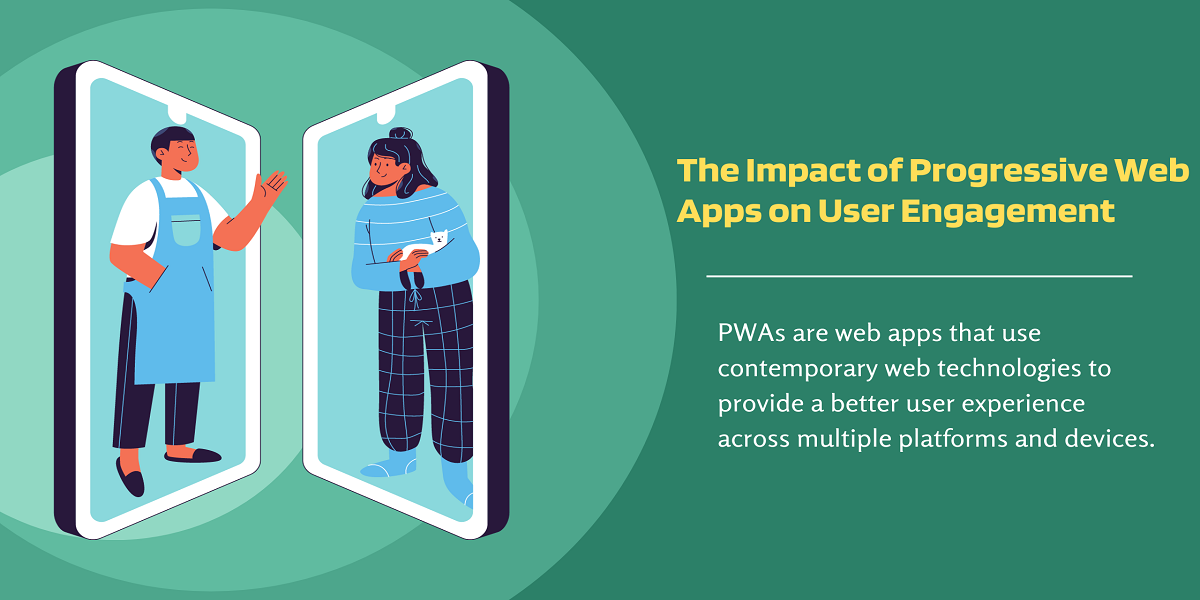
The Impact of Progressive Web Apps on User Engagement
- By Eva Miller
- 20-11-2023
- Web Apps
Progressive Web Apps (PWAs) are an innovative method of web development. It has changed the way people engage with internet material. These cutting-edge web applications blend the most remarkable aspects of web pages with mobile apps. These characteristics provide users with a smooth and responsive experience. The level to which people interact with and remain engaged with an online platform or application is known as user engagement. It is an integral part of the digital world. Several things influence this involvement. It takes into account load speeds, functionality, and user experience.
As a modern consumer navigating the digital realm, I like the convenience and accessibility that Progressive Web Apps (PWAs) provide. PWAs have become an essential part of my everyday life. Whether I am buying online, reading the latest news, or simply remaining connected with friends. These web apps not only enhanced my online experience but also sparked my interest in their influence on user engagement.
Understanding Progressive Web Apps (PWAs):
Progressive Web Apps are a novel way to online development. It blurs the distinction between standard web pages and native mobile applications. PWAs are web apps that use contemporary web technologies to provide a better user experience across multiple platforms and devices. One of the distinguishing features of PWAs is their ability to perform flawlessly both online and offline. It provides consumers with a consistent and engaging experience. These apps are designed with an emphasis on responsiveness, flexibility, and performance in mind. These features guarantee that they perform effectively on a broad range of devices. These range from desktop computers to smartphones and everything in between.
PWAs are notable for their dependability. They may load promptly even in demanding network conditions due to service workers that cache vital assets. PWAs are installable, allowing consumers to add them to their home screens like native applications without going via an app store. This installation method increases user engagement and gives simple access to the program. PWAs are also linkable, which means they can be shared via URLs, making them discoverable via search engines and social media.
PWAs have several advantages. They begin by bridging the gap between online and mobile app experiences. PWAs enable organizations to reach a larger audience with a single codebase by integrating the best of both worlds. This not only lowers development and maintenance expenses of a web development company but also improves the user experience. It allows users to access the program from any device. PWAs are very efficient, leveraging progressive enhancement to adapt to the capabilities of a user's device. Therefore lowering data use and enhancing speed. As a result, PWAs are extremely quick and responsive, providing an enjoyable user experience.
The Importance of User Engagement:
User engagement refers to the amount and quality of connection and involvement that users have with a specific online platform, website, application, or content. It includes a wide variety of behaviors. These are clicking on links, reading articles, watching videos, sharing material, writing comments, making purchases, and more. User engagement does not refer to a single activity but rather to the total user experience and the amount to which users actively interact and spend their time and attention in the digital environment.
User engagement plays a vital role for organizations for many compelling reasons. To begin with, engaged users are more likely to become committed consumers. When people contact with a brand or its content continuously, they establish a sense of connection and trust. It makes them more likely to make purchases or perform desired activities. For example, signing up for newsletters or services. Increased customer loyalty leads to more excellent retention rates and lifetime customer value.
User participation is an excellent source of feedback and ideas. Users that actively interact with a digital platform contribute data and input. These inputs aid in improving and enhancing the user experience. This user-generated data is useful for making data-driven choices, developing goods or services, and personalizing content to match the requirements and tastes of consumers. Measuring user engagement is critical for determining how effectively a digital platform or content performs.
Several measures are routinely used to assess user involvement, including:
- Page Views: Page Views are the number of times a page or piece of information is viewed. Higher page views frequently imply greater user interest.
- Time on Page: This metric tracks how long people spend on a particular page or information. Longer periods often indicate greater involvement.
- Click-Through Rate (CTR): CTR is the proportion of people that click on a certain link or call to action. A higher CTR shows that the user is more interested.
- Bounce Rate: This indicator measures the percentage of people who leave a website after just seeing one page. Lower bounce rates imply a more enjoyable user experience.
- Social Shares: The number of times a piece of content is shared on social media platforms shows user involvement and the potential for extra exposure.
- Comments and Interaction: The amount of comments, likes, shares, and other interactions on content or postings is a direct measure of user involvement with the material.
- Conversion Rate: This is the proportion of users who fulfill a certain goal, such as completing a purchase or signing up for a newsletter.
- Churn Rate: In subscription-based services, churn rate is the percentage of subscribers that discontinue using the service. A lower churn rate indicates more user engagement and retention.
How PWAs Improve User Engagement
PWAs, like native apps, also provide the convenience of push notifications. Businesses may use these notifications to update users on new material, changes, promotions, or other pertinent information. This direct channel of contact improves user engagement and retention. It's an excellent technique to re-engage consumers who may have abandoned the app. It reminds them of its worth and tempts them to return. The responsiveness of PWAs across a variety of devices. This adaptability guarantees customers a consistent, high-quality experience regardless of their device. PWAs ensure that users may access information and services. It can be at their workstations or while on the go. As a result, businesses may reach their target audience wherever they are. PWAs are distinguished by their offline functionality.
PWAs can cache content via service workers, allowing users to interact with the app without an internet connection. This constant access to essential functions is a significant advantage. It is helpful, particularly in areas with intermittent network access. Push notifications are available in PWAs, just as in native apps. Businesses may utilize these notifications to inform users about new content, upgrades, discounts, and other updates. This open communication channel encourages user engagement and retention. It's a great way to re-engage customers who have lost interest in the app, reminding them of its value and enticing them to return.
Real-world examples of PWA:
Progressive Web Apps (PWAs) have grown in popularity and efficacy across several sectors. The examples prove how PWAs may improve user engagement and business outcomes in a variety of industries.
Some real-world examples include:
- Flipkart: Flipkart is one of India's leading e-commerce platforms. It launched a PWA to solve many of its consumers' concerns about sluggish network access and limited device storage. The PWA improved load speeds, especially on 2G networks, and resulted in a 70% increase in conversions. Flipkart found a 40% increase in customer re-engagement. The 70% increase in conversions at Flipkart shows that the PWA was quite effective in motivating users to complete their purchases. The 40% increase in re-engagement suggests that users were returning to the site more frequently. It is a strong sign of enhanced engagement and user happiness.
- Forbes: Forbes, a well-known media organization, deployed a PWA to increase user interaction on their website. Forbes had a 43% increase in sessions per user and a 100% increase in engagement after switching to a PWA. The PWA's shorter loading times and enhanced performance contributed significantly to these remarkable results. Forbes' 43% increase in sessions per user implies that people were more interested in examining the website's content. The 100% increase in engagement shows a doubling of user engagement. These are reading articles, viewing videos, and sharing material, demonstrating the PWA's beneficial influence on user engagement.
SEO Benefits:
PWAs have evolved into an effective tool for optimizing search engine optimization (SEO) efforts. It also increases a website's exposure in search results. One of the primary SEO benefits of PWAs is their inherent speed and performance improvements. Search engines like Google emphasize websites that deliver a quick and responsive user experience. It is so because customer happiness is an important ranking element. PWAs, with their shorter loading times and enhanced speed, contribute to a good user experience. It can benefit search engine results. Google created the notion of "Core Web Vitals." It focuses on user experience factors, such as loading speed and interaction. PWAs excel at achieving these Core Web Vitals, making them more likely to rank better in search results.
PWAs are adaptable and adapt flawlessly to different devices and screen sizes. It is another SEO consideration. Mobile friendliness is a search engine ranking signal. PWAs provide this responsiveness by default, increasing the website's chances of ranking on SERPs.
The link between SEO and user engagement is unmistakable. Engaged users spend longer on a website, read more pages, and engage with information. These are all positive signs for search engines. The longer consumers remain on the page and investigate it, the more search engines perceive this as an indication of high-quality, relevant material, potentially increasing the website's exposure in search results.
Challenges and Considerations:
PWAs have garnered recognition for their many benefits. However, organizations must be aware of possible hurdles and the need for a well-thought-out PWA plan for effective adoption. Insufficient support for PWAs on iOS devices is a barrier. While PWAs perform well on Android and current web browsers, iOS has some limitations. This means the user experience may be less smooth for Apple device users. Another issue is a lack of exposure in app marketplaces. PWAs, unlike native applications, are not listed in traditional app stores. It might hinder discoverability and user uptake. To address these difficulties, a solid PWA strategy should include clear communication and marketing activities to educate consumers on how to install and use PWAs.
Another factor is user awareness. As many users are unfamiliar with PWAs, education is critical. To encourage adoption, it is vital to emphasize the benefits and capabilities of PWAs. Building a feature-rich PWA might be technically challenging. It necessitates more development resources and experience. PWAs save data on users' devices. PWAs, like any other software, need constant maintenance and upgrades. Regular updates are required to guarantee that the PWA stays functioning and in step with emerging web standards.
Cross-browser compatibility is another element to consider. Since different web browsers may display other behaviors or quirks, it needs much testing and development work. To adequately address these difficulties, a well-thought-out PWA strategy is required. It should start with defined objectives connected with the organization's goals. Enhancing user engagement, increasing mobile conversions, or decreasing bounce rates are a few of them. Extensive testing and quality assurance methods assure faultless performance, security, and a fantastic user experience.
Implementing PWAs for User Engagement
Implementing Progressive Web Apps is a strategic strategy to increase user engagement. To reap the benefits of PWAs, organizations should emphasize responsive design, improve speed, and integrate service workers for offline functionality. Push alerts and app-like experiences are essential for keeping users interested. An easy-to-use onboarding process drives uptake. Users must have confidence that their data is protected. Thus, security and data privacy are non-negotiable. Businesses may create a seamless user experience by concentrating on speed, easier navigation, and personalization. They can also upgrade the PWA on a regular basis. Monitoring engagement data and doing A/B tests help to fine-tune the PWA for optimum user involvement and pleasure. Educating consumers on the unique benefits of PWAs ensures that they make the most of this technology. Thereby enhancing total user engagement.
Conclusion:
Progressive Web Apps have a favorable influence on user engagement. It provides a bright picture of the digital world. PWAs have ushered in a new era of user-centric interactions. It enables quicker loading times, improved responsiveness, offline capabilities, and the creation of an app-like experience. As we've gone over the different capabilities and benefits of PWAs, it's clear that businesses now have a strong tool at their disposal to boost their online presence and engage with their audience in more meaningful ways.
Looking ahead, the excitement around PWAs is well-founded. PWAs are at the vanguard of this shift, offering a future where user involvement is more engaging and rewarding than ever before. Businesses can unlock the full potential of PWAs with the appropriate strategies and dedication to user pleasure. It enables a more engaging and successful digital future for everybody.
Recent blog

Harnessing Social Media: Tactics For Powerful Marketing Success Achievement
Social Media | 25-07-2024
7 Hidden Secrets of MSI Laptop Boot Menu Key
Technology | 24-07-2024




